Analyzing Intel Core M Performance: How 5Y10 can beat 5Y71 & the OEMs' Dilemma
by Brett Howse & Ian Cutress on April 8, 2015 8:00 AM ESTClosing Thoughts
There is a lot to say about Core M performance. We have tested three very different devices, all with Core M inside - each device tackles the design philosophy of Core M from different directions, and it comes across in the results based on where each device stands. We started this analysis to answer the question "how can 5Y10 beat 5Y71?', and the results answer that quite clearly.
Dell Venue 11 Pro 7000 (5Y71)
Starting with the Dell Venue 11 Pro 7000, this is an 11 inch tablet with passive cooling and a small chassis. The plastic exterior helps with skin temperature, but hinders the ability of the device to radiate the heat that it generates.
This chart shows where Intel believes Core M can be done in a passivly cooled device, and it assumes a metal chassis which the Venue 11 Pro 7000 lacks. Device thickness, material, and chassis size all play a big factor in how much heat can be dissipated. Under sustained use, the Venue 11 Pro can get warm to the touch, but as seen in the previous pages the actual SoC temperature can spike very rapidly. This compromises performance, although everything is relative. Compromised Core M CPU performance is still quite a bit more powerful than a Silvermont core in an Atom.
Lenovo Yoga 3 Pro (5Y71)
The Yoga 3 Pro on the other hand is a convertible tablet, and is the only Core M device in our test with active cooling. Lenovo has gone to great lengths to ensure that it does not get hot in the hand, since it most certainly can and will be used when held. It has the lowest SoC temperature of any of the devices by quite a bit, although it is of course helped by the inclusion of a fan. Lenovo has clearly set a target SoC temperature of 65°C as the maximum they are comfortable with in order to keep skin temperatures where they want them. It does not really hurt the device in all workloads, and as we have seen the Yoga 3 Pro can even outperform a Core i5-5200U in cherry-picked scenarios. On sustained maximum performance though, the lower SoC temperature means that the CPU and GPU must cut back sooner than the other devices, which limits performance.
ASUS Zenbook UX305 (5Y10)
The ASUS Zenbook UX305 is a completely different device. It is a laptop, so skin temperatures are not as big of a concern, and while it does get hot at around 48°C on long workloads, that heat is well away from where you would normally be touching the device. Also, being made out of aluminum is clearly a huge benefit for a passively cooled device such as this, as it allowed the ASUS to consistently outperform the other Core M devices despite it being the lowest boost frequencies in the test. The performance of the Zenbook was very consistent, even on extended workloads, and on the DOTA 2 test, the Zenbook even outperformed the Latitude, although that was less to do with thermals and more to do with the lack of memory bandwidth on the Dell laptop.
Core M
So with all of this data, what more do we know about Core M? Clearly, Intel’s goal with Core M is to provide excellent performance on short workloads. It has higher boost frequencies than the Core i5-5200U that was included in this test, and it has 4 MB of L3 cache as well compared to 3 MB of cache on the i5. On certain workloads, performance can even surpass the i5-5200U. Race to sleep is not a new idea, but that is what Core M is designed to do, and it does it well. Run on very little power, and then when tasked with work, get it done as quickly as possible and get back to the low power mode. This is not unique to Core M of course, as the Core i5 does the exact same thing, however the much more restrictive thermal envelope of just a 4.5 watt TDP means that sustained workloads just have to suffer compared to a device with a 15 watt TDP.
We did see that happen too. The Core M scored very well in the PCMark 8 benchmarks, which attempt to emulate real world use rather than just performing a single task until it is done. The burst nature of this allowed Core M to have enough time in between work to keep the temperatures in check. On sustained work, this was not always the case.
On the 5Y71 vs. 5Y10 front, we have some clear lines drawn:
| Intel Core M Performance | |||
| 5Y10 Result ASUS UX305 |
5Y71 Result Lenovo Yoga 3 Pro |
5Y71 Result Dell Venue 11 Pro 7000 |
|
| Cinebench R15 ST | 82.14 pts | 90.85 pts | 86.00 pts |
| Cinebench R15 MT | 210.66 pts | 196.00 pts | 175.00 pts |
| PCMark 8 - Home | 2655 pts | 2443 pts | 2606 pts |
| PCMark 8 - Creative | 3056 pts | 3110 pts | 3064 pts |
| TouchXPRT 2014 | 654 pts | 820 pts | 764 pts |
| 3DMark Sky Diver | 2773 pts | 1624 pts | 1820 pts |
| 3DMark Cloud Gate | 4251 pts | 3685 pts | 3753 pts |
| 3DMark Ice Storm | 47527 pts | 49619 pts | 44911 pts |
| DOTA 2 | 34.0 fps | 26.5 fps | 25.2 fps |
It also shows just how much the individual device plays in how much performance is available. The ASUS has by far the best cooling solution of the three Core M devices, which is helped of course by the form factor. Lenovo could not get away with a 50°C surface temperature on a device that can be used as a tablet. It just would not work. The form factor of the Yoga 3 Pro plays against it on sustained workloads. The Dell Venue 11 Pro allowed a much higher SoC temperature, but it would also spike there very quickly. What we would really love to see is the Core M-5Y71 processor inside of the Zenbook to see just how much the increased boost of the 5Y71 compromises the performance on longer duration workloads, if it does.
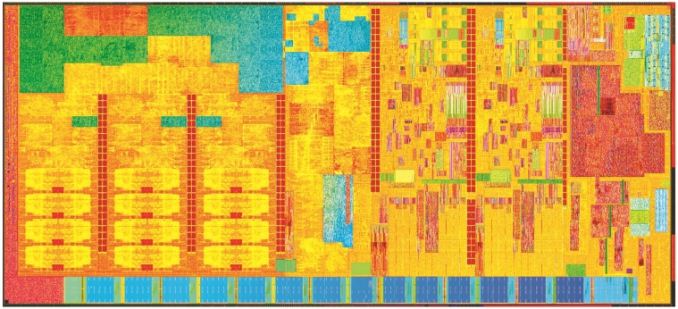
Die Shot of a Core M Processor
Is Core M a good processor? Or is it slow? It is clearly slower than a Core i5, but it would be hard to expect it not to be. On many daily workloads, it performs very well. On things like web browsing we are already to the point where the Yoga 3 Pro outscores a Core i7-860 4C/8T 95 watt desktop CPU from 2009 in web benchmarks. Since Core M is mainly aimed at thin and light devices, it can be expected that these are the kinds of workloads that one would perform on them. Many companies have jumped onboard with the smaller processor, as it allows a thinner and lighter device, and the possiblity of having no moving parts. Core M enables this with a much lower TDP than the next tier of mobile processors from Intel, as well as a smaller overall SoC which is thinner as well.
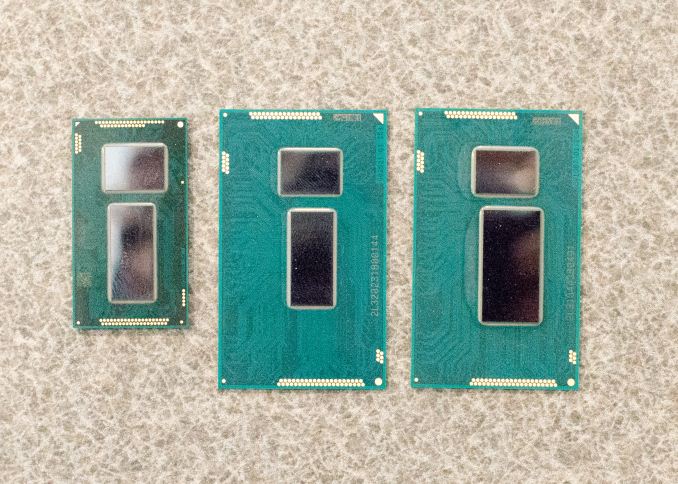 Broadwell-Y (left) vs Broadwell-U (center) vs Haswell-U (right)
Broadwell-Y (left) vs Broadwell-U (center) vs Haswell-U (right)
With the rise of tablets, the migration from hard desktops to smaller form factors has been unprecedented and Core M gives much more CPU performance than any tablet SoC available right now, at the expense of the additional cost the premium product brings. It is well suited to the types of workloads that many of us do during a typical day. There has been a lot of design wins already for this processor, covering a large range of device types and manufacturers. Even Apple has decided that there is a niche where a thinner and lighter version of their laptop may be of good use to their customers.
That said, there are a few other differences that set Core M apart from the mainline Core processors that need to be noted. For example, even though it shares the Gen8 Graphics with the Core i3 / i5 / i7 models in Broadwell-U, it is not quite as capable. It only has software HEVC decode for instance, which means that it might not be suitable for a Home Theatre PC without additional graphics helping out. Gaming is also a scenario where Core M can come up short, but only if you are comparing it to typical PC games. Tablet style games will have no issues, and Core M can perform similarily to other tablets in the GPU department.
In the end, we will quote one of Brett's favorite Formula 1 announcers and author, the great Steve Matchett. Everything is compromise. In Formula 1 racing, each corner of the track would need a different setup on the car for maximum results for that corner, and on the straights you would want most of the car’s downforce removed. Therefore every race and even every corner of a race is compromised for the maximum overall lap speed. The same can be said of Core M. In order to get something as powerful as the Core architecture inside of a fanless tablet, there is going to be compromise. In a Core M device, that is going to be sustained performance. What you give up in sustained performance though allows a thinner and lighter device, in form factors that would never have been possible with Core even one year ago. But it also means that the Core M SKU designation is only a sign of general performance, rather than absolute positioning. For that, we have to compare and contrast each unit in a review. Luckily, we hope to cover a large number of the important models over the next few months.



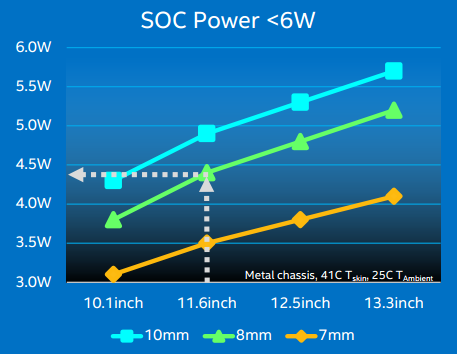
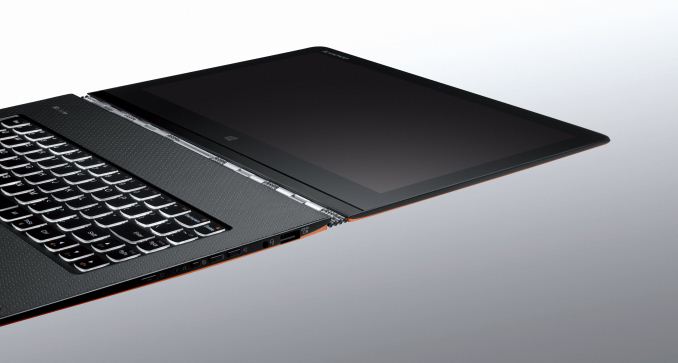
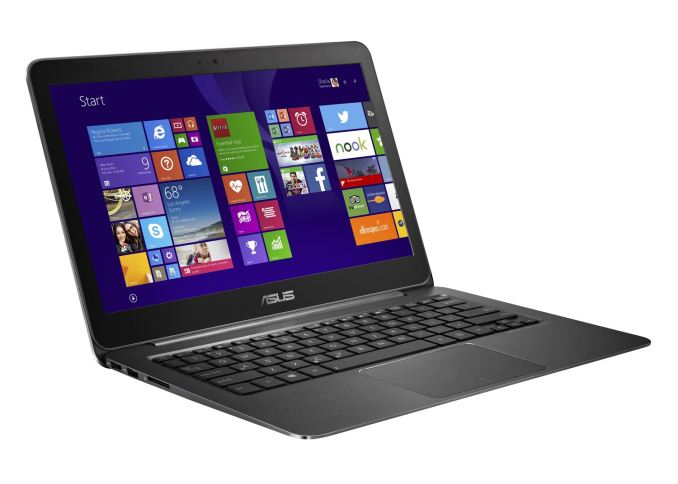








110 Comments
View All Comments
zodiacfml - Wednesday, April 8, 2015 - link
A long for this look at the performance Core M. Thanks. Like all nice, popular movies the end is pretty expected after a review from the Asus UX305. It's also good that the Dell is there to provide the scores for no limitation on cooling for long continuous loads.After all this, I don't see any problem. The performance of the Asus is pretty expected as well having a tradional notebook design which is fairly overkill for the SDP/TDP.
I was a PC overclocker many years ago and then realized that underclocking and overclocking at the same time would be ideal. I believe the race to wider CPU dynamic range has become mainstream.
dragonsqrrl - Wednesday, April 8, 2015 - link
"Each model comes with 4MB of L2 cache" On the first page.Shouldn't that be L3 cache?
dananski - Wednesday, April 8, 2015 - link
I love how the Asus tries to draw a piano keyboard in the PCMark 8 Creative graph. Very creative of it.DryAir - Wednesday, April 8, 2015 - link
The temperature x time graphs are all messed up. The lines goes "back" on many ocasions, indicating 2 different temperatures on a same time stamp. You should check the settings on whatever program you are using to generate these graphics.be_prime - Wednesday, April 8, 2015 - link
I just signed up to comment on the same thing -- the graphs are so clearly distorted by some (no doubt well-intentioned) spline/smoothing that much (even most?) of the data we see here may be the product of a spline or interpolation process, and not represent a data measurement. Where the line goes "back", as DryAir pointed out, it implies time travel.That's a very big miss for a site that I've considered to be thoughtful and authoritative. The approach you took here presents false and interpolated data and obscures the quality of your research. Don't let the goal of an attractive graph ruin the whole point of the graph: showing the data.
These graphs are obviously impossible due to the spline/interpolation used, and should be replaced by a scatter plot or normal line graph.
Brett Howse - Wednesday, April 8, 2015 - link
As I mentioned on the Devices and Test page, sometimes the devices were very heavily loaded and they were not able to log consistently. Sometimes they would log twice in the same second, but with slightly different values. One log would be time 0:00:01:05, and another would log 0:00:01:95 (for instance), but both would be truncated to the same second. Unfortunately that's just the limit of the software, since it only logs time to the nearest second. A second can be a lot of time for a CPU.be_prime - Thursday, April 9, 2015 - link
That's fine because those data points represent measurements.The problem here is you've used interpolated splines/curves which, in this case, actually show impossible or false information: the curve leaning "left" implies that the x-axis (time) is decreasing: that's time travel, and it'd be a bigger story than the Core M for sure, right?
Also recognize that if you're gathering data points, but drawing a line, you're always implicitly creating an interpolation between those points (at least in viewers minds). Usually, it doesn't matter so much. Here, the resulting lines are false, and I think Anandtech is a better publication than that.
As it stands, the interpolation/smoothing on your graphs implies time travel. Respectfully: please correct this (or, patent the relevant technology and profit!). If you're going to make your graphs look "pretty" and don't care if they're correct, I can't trust your results.
DryAir - Friday, April 10, 2015 - link
Sarcastic time travel jokes aside, I agree that you should change it somehow. Perhaps just change the data points to be connected to a straith line, instead of a smoothed one. Right now its looking very amateuristic, not matching an otherwise great and highly technical review.Brett Howse - Friday, April 10, 2015 - link
Ice Storm was the worst offender so I've re-generated the graphs with straight lines. There just was not enough data points on that one because it was so short.gw74 - Wednesday, April 8, 2015 - link
I am furious that OEMs are using Core M in ultrabooks. It is the solution to a problem which does not exist. The Samsung Series 9 / ATIV 9 Plus use full fat i5 and i7 ULVs and the 2 tiny fans hardly ever come on. when they do, they sound like mice whispering. and huge battery life.Core M is not progress when used in the ultrabook factor. it is a step backwards and a ripoff.